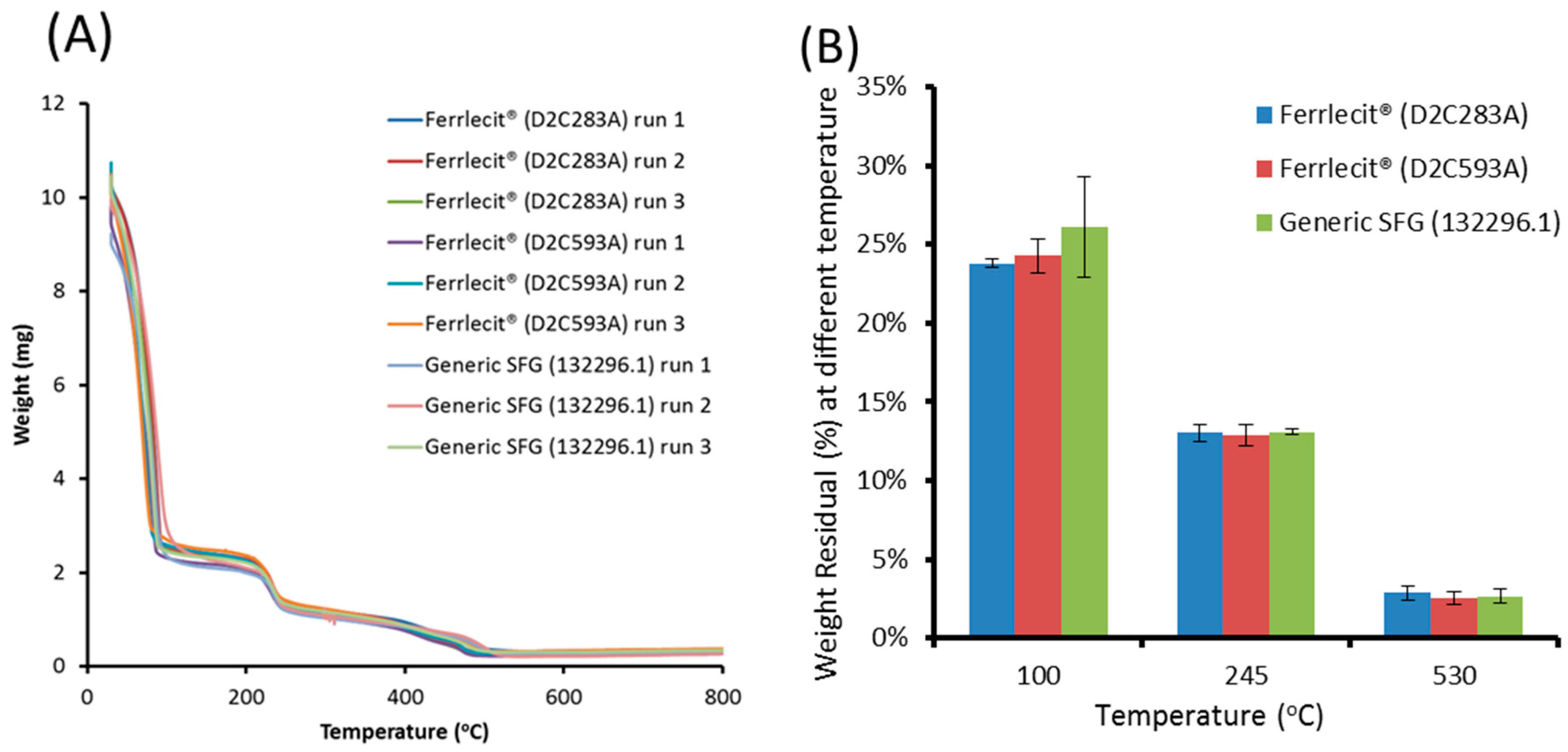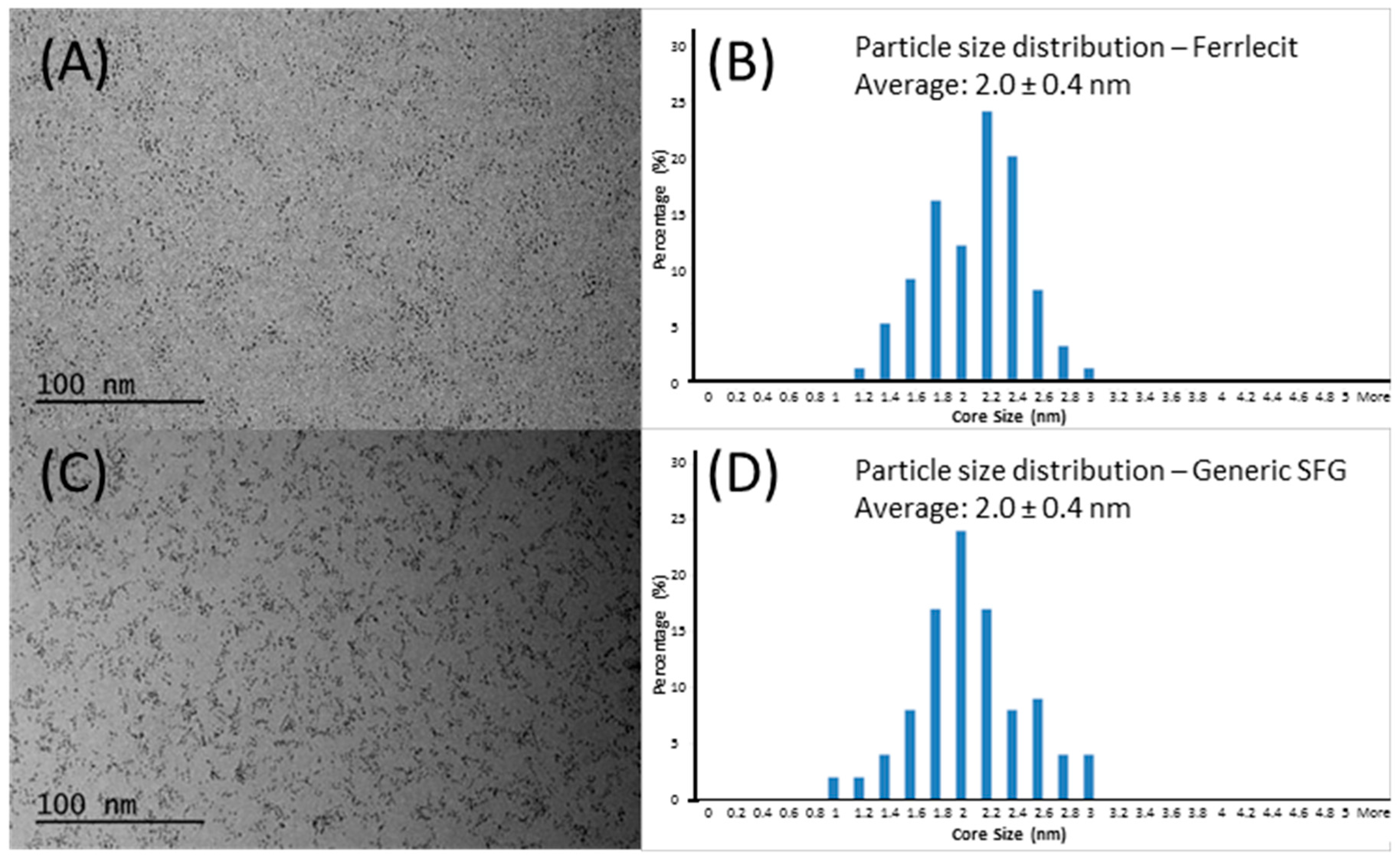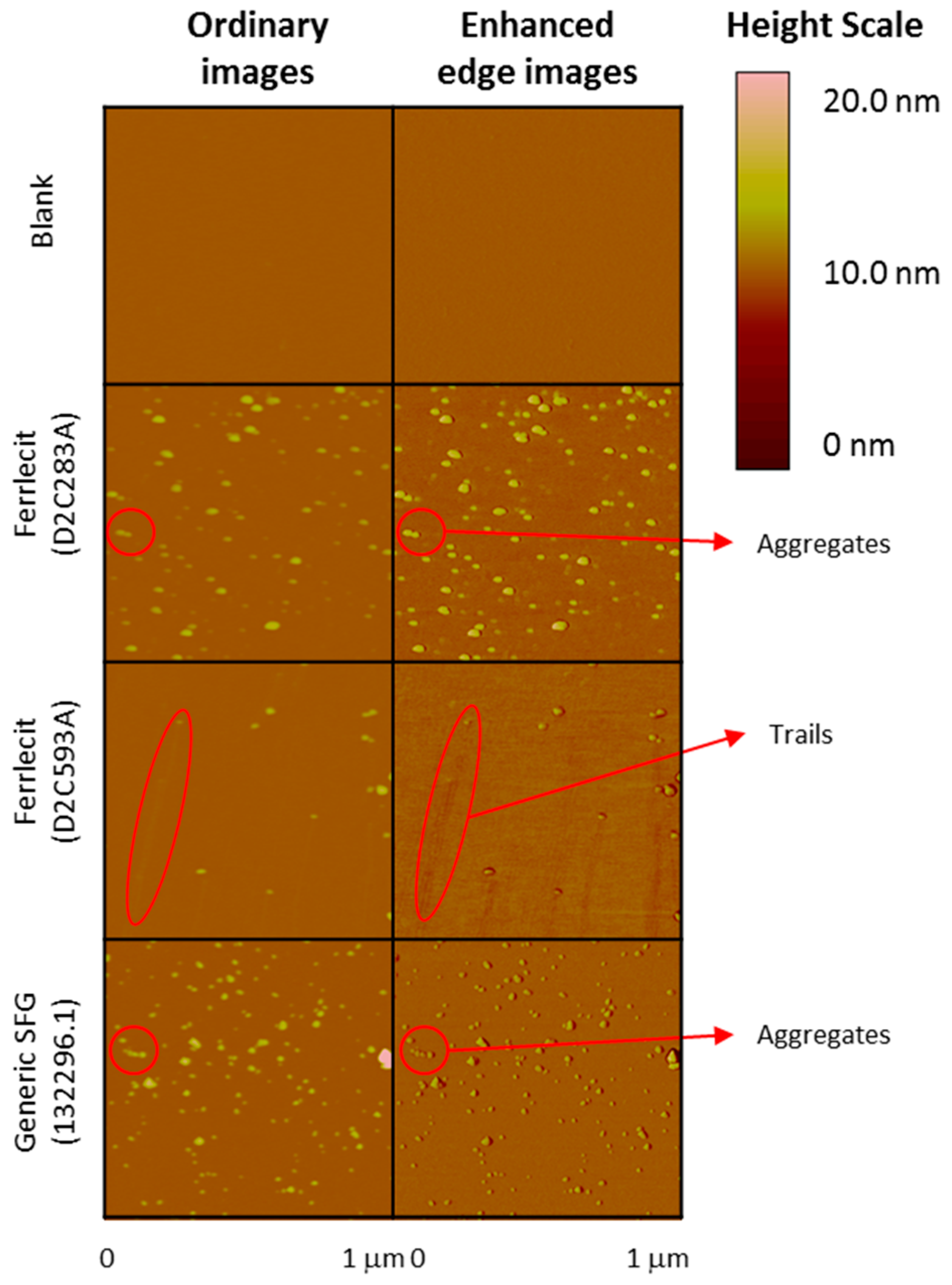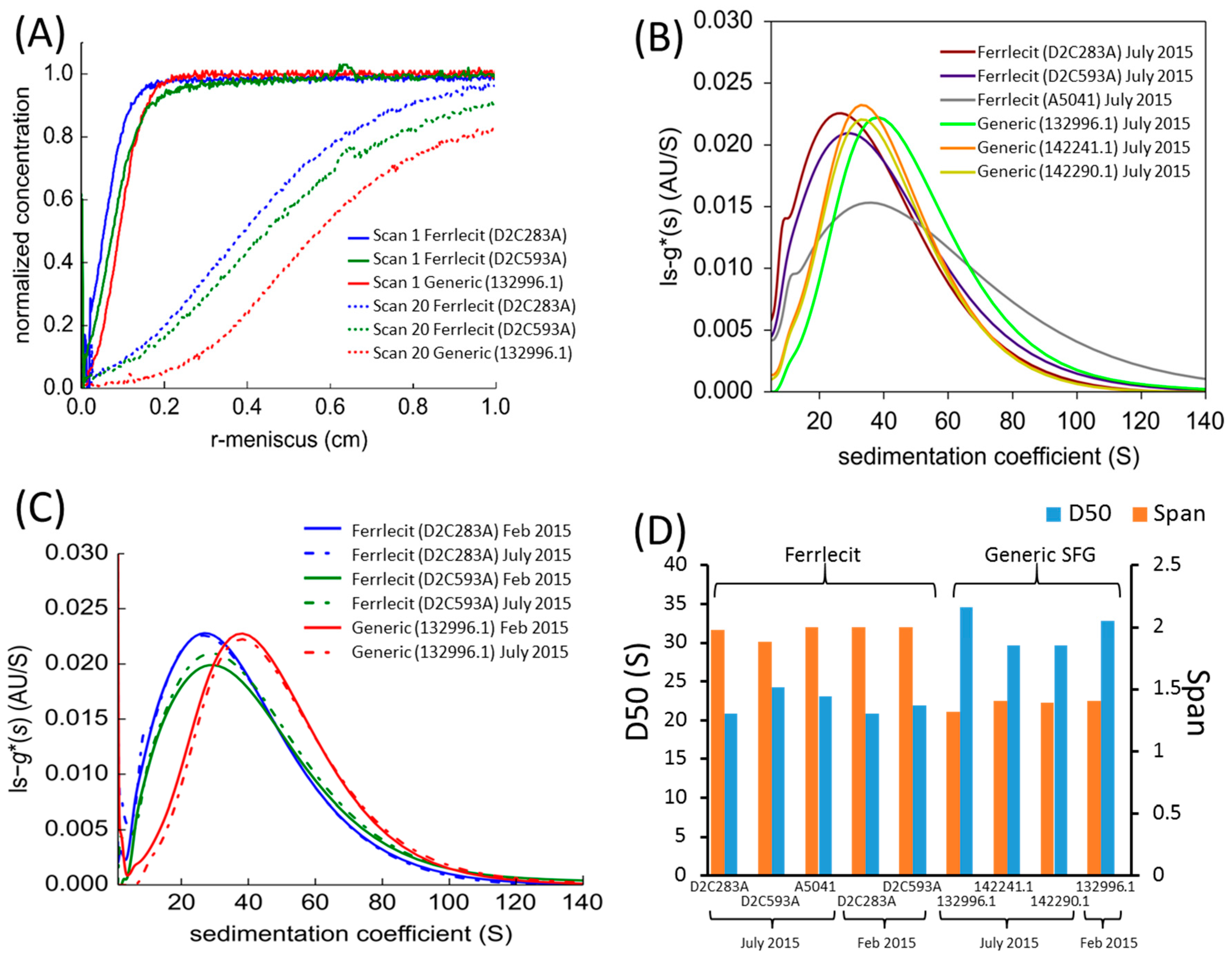1. Introduction
Among iron’s many critical roles in metabolic processes, the most essential function is in the synthesis of hemoglobin to meet the need for oxygen transport. Iron replacement medications formulated as parenteral nano-sized colloids of carbohydrate-coated ferric oxyhydroxide are an effective treatment for iron deficiency anemia in chronic kidney disease patients receiving hemodialysis and responding to erythropoiesis stimulating agents. As of May 2017, innovator iron-carbohydrate complex drug products on the U.S. market include INFed (iron dextran), Dexferrum (iron dextran), Ferrlecit (sodium ferric gluconate (SFG) complex), Venofer (iron sucrose), Feraheme (ferumoxytol), and Ferinject (ferric carboxymaltose). These iron colloidal nanoparticle products differ in the composition of their carbohydrate shells, iron core sizes and hydrodynamic radii. Nevertheless, in humans these drugs are distributed and cleared from the bloodstream through a similar process that involves phagocytosis in the reticuloendothelial system (RES) [
1]. In addition, these drug products may have different clearance rates as a result of their varied compositions. The mechanism of action of these iron colloidal drugs involves uptake by cellular lysosomes in which iron ions are released from the colloidal nanoparticles and become part of the intracellular labile iron pool for use in biological processes [
2].
The availability of generic drugs lowers costs and enhances access to safe and efficacious drugs for patients who need them. In this case, the presence of generic SFG may provide a more affordable treatment option for iron deficiency anemia patients intolerant to iron dextran [
3] who face more costly alternatives, such as the innovator iron sucrose and SFG products. In March 2011, U.S. Food and Drug Administration (FDA) approved the first generic copy of Ferrlecit (SFG complex) among all parenteral iron-carbohydrate colloidal products. As of May 2017, the generic copy of intravenous SFG complex in sucrose injection remains the only approved generic product of intravenous iron colloidal nanoparticles in the U.S.
The generic version of SFG complex in sucrose injection was approved based on qualitative (Q1) and quantitative (Q2) formulation sameness, in vivo bioequivalence studies, and in vitro characterizations [
4]. The FDA recommends generic SFG products to be Q1/Q2 the same as Ferrlecit. For in vivo bioequivalence studies, the FDA recommends a single-dose, randomized, parallel pharmacokinetic (PK) bioequivalence study in healthy subjects, with measurement of plasma total iron (TI) and transferrin-bound iron (TBI). To demonstrate bioequivalence between the brand and generic SFG complex formulations, the 90% confidence intervals of the generic drug for the maximum value of the difference in concentration and area-under-the-curve between TI and TBI over all time points measured should be within an 80.00% to 125.00% range of innovator product’s values [
5].
In addition to in vivo PK evidence, the FDA recommends comparative in vitro studies to illustrate formulation sameness and to predict any potential differences that may give rise to potential differences in in vivo stability and distribution patterns of the iron-carbohydrate complex. A series of comparative physicochemical characterization tests are recommended to ensure similar iron core size, iron oxide crystalline structure, iron environment, composition of carbohydrate shell, overall particle morphology, as well as comparable labile iron under physiologically relevant conditions [
6]. It is recommended that these characterization tests be conducted with at least three lots of each of brand and generic products. The structural features and release profiles of iron colloids are important to ascertain compatible tissue distribution and comparable in vivo leakage of labile iron between the brand and generic SFG products. In recent years, advanced analytical techniques have become available for characterizing physicochemical properties of iron colloidal nanoparticle products such as ferumoxytol [
7], iron isomaltoside [
8], and iron sucrose [
9] as well as the stability of SFG complex [
10,
11].
For example, molecular weight distribution of SFG polymers is commonly determined by size exclusion chromatography (e.g., gel permeation chromatography (GPC) [
10]) and also explored with asymmetric field-flow fractionation (AFFF) [
12]. The size distribution and zeta potential of SFG nanoparticles can be measured by a dynamic light scattering (DLS) particle sizing and zeta potential analyzer [
10], and the iron core size can be measured by atomic force microscopy (AFM) [
13] and transmission electron microscopy (TEM) [
14]. More advanced analytical tools such as sedimentation velocity analytical ultracentrifugation (SV-AUC) [
15] have been applied to determine the hydrodynamic radius distribution of nanoparticles.
The objective of the current study was to conduct physicochemical characterizations between Ferrlecit and its generic counterpart using state-of-the-art analytical technologies in support of follow-up in vitro cellular uptake [
16] and rat biodistribution [
17] studies. In this report, we present inductively coupled plasma-mass spectrometry (ICP-MS), total organic carbon (TOC) measurement, thermogravimetric analysis (TGA), viscosity measurement, cryo-TEM, AFM, SV-AUC, GPC and AFFF methods for the physicochemical characterizations of the innovator and generic SFG complex products. Coupled with the ongoing clinical study comparing the labile iron level in healthy volunteers [
18], the FDA-funded post-market studies intended to illustrate comprehensive surveillance efforts ensuring safety and efficacy profiles of generic SFG complex in sucrose injection, and also to shed new light on the approval standards on generic parenteral iron colloidal products.
4. Discussion
To gain approval of Abbreviated New Drug Applications (ANDA) in the U.S., generic iron complex products need to meet compendial or other regulatory quality standards from chemistry, manufacturing and control perspectives. Additionally, at least three lots of each of generic and brand iron complex products should be used to demonstrate comparable physicochemical characteristics of iron core, carbohydrate shell, particle size and morphology, and labile iron. Due to a limited number of commercially available Ferrlecit and generic SFG lots on the market at a given time, the current study has measured the elemental iron and carbon content, thermal properties, viscosity, particle size (DLS and AFM) and zeta potential of two Ferrlecit lots and one generic SFG lot to evaluate whether or not the brand-to-generic difference is greater than the inter-batch variability of the brand product. The sedimentation coefficient and molecular weight of three lots of each generic and brand SGF complex products were determined in order to evaluate the observed differences between brand and generic products. Previous post-marketing studies have shown comparable iron content and molecular weights [
11] and labile iron levels in formulations [
24] between Ferrlecit and its approved generic copy on the U.S. market. The results obtained from this study further assess physicochemical equivalence between brand and generic SFG products at the formulation, nanoparticle and polymer levels. At the formulation level, there is no noticeable difference in iron and carbon content (
Table 2), viscosity (
Table 3) and decomposition profiles, and residual mass based on the TGA analysis (
Figure 1), indicating a comparable chemical composition.
At the nanoparticle level, the size of iron colloidal nanoparticles has an important implication for the core surface area available for dissociation and release of the reduced ferrous iron from the colloidal ferric oxyhydroxide cores [
25]. The brand and generic SFG products have similar size distributions of SFG complex (DLS results in
Table 4) and iron core (cryo-TEM results in
Figure 2 and AFM results in
Figure 3 and
Figure 4), but SV-AUC analysis (
Figure 5) shows that generic SFG has a higher and narrower sedimentation coefficient distribution than Ferrlecit. SV-AUC is a very sensitive analytical technique to characterize nanoparticles. Although it is not possible to translate the sedimentation coefficients into molecular weight without known buoyancy properties, the sedimentation coefficient is proportional to molecular weight and hydrodynamic radius assuming that all the SFG complexes have a similar hydrodynamic shape [
26]. The generic SFG has higher and narrower sedimentation coefficient distributions (
Figure 5D) with a smaller inter-batch variability (
Figure 5B) but a similar intra-batch variability at two time points (
Figure 5C) in comparison with Ferrlecit, which is consistent with the slightly higher iron content that was still within the acceptance limits based on elemental analysis.
At the polymer level, GPC and AFFF-MALS have been used to characterize the MW distributions of SFG colloidal macromolecules. Based on the GPC results (
Table 6), M
w values obtained by both Labs 1 and 2 using Method 1 were quite comparable between brand and generic SFG complex products; however, the M
w values were not consistent with the labeled M
w distribution of 289,000–440,000 Da based on the GPC method [
21]. In contrast, the GPC analysis using Method 2 provided M
w distribution results consistent with the labeled value. Notably, Method 1 used a polyhydroxy methacrylate gel column which had a 33-fold larger pore size and 1.6-fold particle size compared to the silica-based gel column used in Method 2. The differences in column material, pore size and particle size result in elution at a retention time of 17–19 min with broad peaks and 12–13 min with narrow peaks, for Methods 1 and 2 respectively. Ideally, the separation of polymers in GPC should be based on their hydrodynamic size in the absence of secondary interactions between the stationary phase and the eluent. A delayed eluting peak in Method 1 may potentially underestimate the expected M
w of iron colloids as the molecular weights measured by GPC can be influenced by interaction between the stationary phase and iron-sugar complexes [
27], which could potentially account for the observed differences of molecular weight and PDI (Method 1) between brand and generic SGF complex products. In addition, the mobile phase in two methods was very different as described in
Section 2.4.1. The GPC analysis was a relative rather than an absolute method based on the assumption that the standards and the samples were structurally similar and behaving similarly in given elution conditions. It is important to choose an appropriate column and experiment conditions to conduct GPC analysis of iron complex samples. In addition, when interpreting the GPC data, caution should be taken to understand whether the data difference originates from both individual sample differences as well as the deviations in the methods used by each lab.
The AFFF-MALS analysis (
Table 7) shows that generic SFG (lot 132296.1) has greater M
n and M
w and a lower PDI than Ferrlecit (lots D2C283A and D2C593A). The molecular weight data of brand and generic SFG determined by AFFF-MALS correspond with the sedimentation coefficient trend observed with the SV-AUC technique. Currently, there are no acceptance limits established for the molecular weight range of iron colloidal complex products as determined by AFFF-MALS. Both SV-AUC and AFFF-MALS analyses were conducted by contract laboratories with limited lots of brand and generic samples. Further testing on additional lots should be conducted to better understand the observed differences.
In 2011, the European Medicines Agency (EMA) initiated a discussion on non-clinical studies for generic nanoparticle iron medicinal product applications, and the results of which were later adopted as the reflection paper on the data requirements for generic intravenous iron-based nano-colloidal products [
28]. The non-binding data requirements at the European Union (EU) level encompass those requested by the FDA with additional recommendations such as non-clinical studies (e.g., characterization of RES uptake, biodistribution in animal models). Prior to the discussion, different iron sucrose similar (ISS) products, intended copies of iron sucrose (Venofer), for the treatment of iron deficiency anemia were approved in individual European countries via a decentralized procedure and in some Asian countries with different regulations. The emergence of safety and efficacy concerns with these approved ISS products [
29,
30,
31] may be attributed to the less rigorous standards of those approval processes.
Post-market studies were performed with these ISS products.
Table 8 summarizes comparative in vitro physicochemical characterization, non-clinical studies, and clinical adverse events reported in the literature between Venofer (iron sucrose) and ISSs developed by various manufacturers. Comparing the physicochemical characterizations conducted, except for the IS-Claris product, limited or no physicochemical characterization was conducted for most ISS products. IS-Claris (Claris Lifesciences Ltd., Ahmedabad, India) showed comparable physicochemical properties as the brand product [
32,
33]. When ISS products showed different Fe(III)/Fe(II) reduction potential from the brand product, differences in cellular uptake (e.g., iron sucrose AZAD) [
34], oxidative stress and inflammatory response in rats (e.g., six ISSs in Asia) [
35], hemodynamic and tissue responses in rats (e.g., Generis) [
36,
37], and clinical responses (e.g., Ferex) [
29] were observed. In the Ferex case, there was an increase in incidences of injection site reactions and phlebitis in postpartum and gynecologic operative patients [
29]. The above ISS (iron sucrose similar) products failed to meet the Iron Sucrose Injection USP (United States Pharmacopeia) standard of Fe(III)/Fe(II) reduction potential (−700 to −800 mV [
38]) as an indicator of the labile iron level in the formulation, which is a critical quality attribute impacting in vivo performance of iron sucrose complex products. Switching from the originator’s product (Venofer) to ISS (Mylan SAS, Meyzieu, France) led to destabilization of a well-controlled population [
30] but again no physicochemical characterizations were conducted for this generic iron sucrose complex product.
Comparing the cases of generic SFG in the U.S. and ISS in Europe and Asia, it is evident that at least some physicochemical quality parameters are sensitive predictors of in vivo outcomes for iron complex drug products. Physicochemical characterizations are critical to cross-compare the quality attributes between brand and generic parenteral iron colloidal products, as part of the bioequivalence approach ensuring equivalent efficacy, safety and stability profiles. Regulators recommend clinically relevant parameters or characteristics of nano-sized iron products to support generic drug approval [
4,
28]; generic drug developers, in turn, apply the most appropriate analytical techniques to establish pharmaceutical comparability. It is acknowledged that there are often multiple analytical methods that can characterize the same property of iron-carbohydrate complex products (e.g., cryo-TEM and AFM measuring the iron core size), allowing for cross-method comparison. In addition, since the method parameters can sometimes impact the resulting measurements (e.g., MW determination by GPC), product-specific methodology with an adequately discriminatory power needs to be developed and validated. The applicability of innovative methods (e.g., AFFF-MALS) should be critically assessed. Occasionally, interpreting the characterization data in the context of bioequivalence has become a regulatory challenge as the sensitivity of analytical techniques has steadily and continuously improved over time (e.g., using SV-AUC to compare Ferrlecit and generic SFG). Therefore, the results obtained from physicochemical characterization of iron-carbohydrate complex products need to be evaluated in the context of totality of evidence including in vivo bioequivalence data, formulation, manufacturing process and other information. Bearing the above considerations in mind, generic drug companies are recommended to characterize their proposed generic formulations and the brand products with a meaningful and comprehensive data set based on regulator’s guidance of key quality attributes and with multiple complementary analytical techniques and specified methodology.
In the grand scheme of generic product approval, the FDA actively conducts post-market surveillance studies in addition to pre-market evaluation. Any clinical concerns such as adverse events associated with generic SFG have been closely monitored via FDA Adverse Event Reporting System (FAERS) and the sponsor’s post-market commitments. To date, there has been no evidence suggesting any substitutability issues between brand and generic SFG in the U.S. In addition, FDA-initiated research will evaluate brand-to-generic equivalence, especially the labile iron level, of parenteral SFG complex products in human subjects. The follow-up cellular uptake [
16] and biodistribution [
17] studies were conducted to confirm that the differences observed in some of the physicochemical tests between Ferrlecit and generic SFG do not impact the in vivo biological activities.










